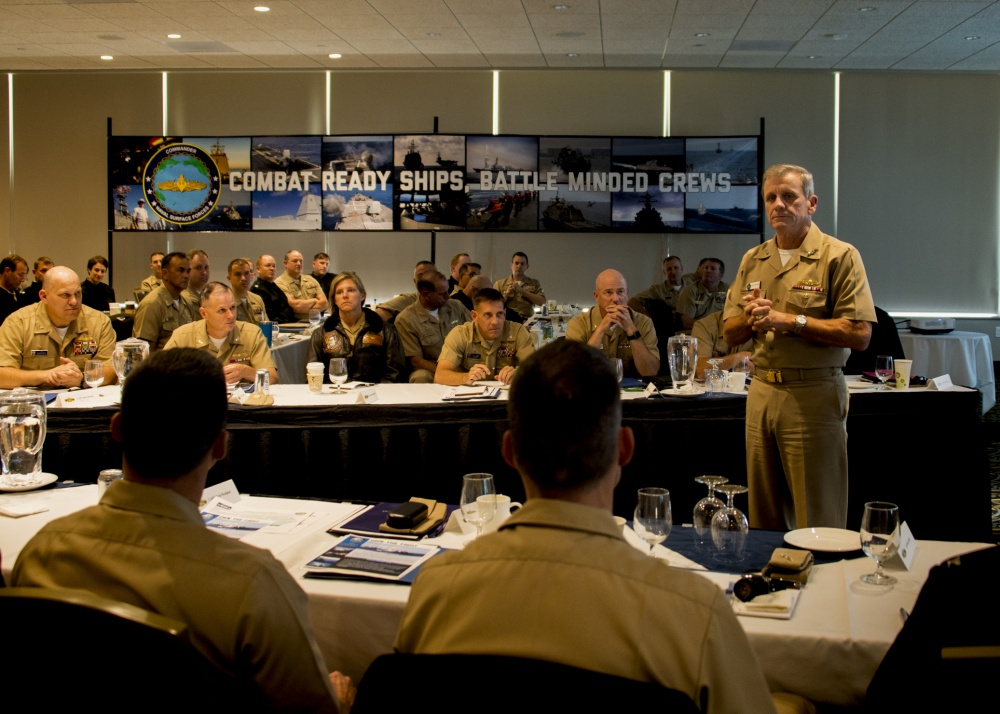
Vice Adm. Richard Brown, Commander, Naval Surface Force, U.S. Pacific (CNSP), hosted his third Commander’s Training Symposium (CTS), Oct. 17 aboard Naval Air Station North Island.
The symposium provided a forum for commodores, commanders, and Surface Fleet leaders to receive updates on Fleet-wide initiatives, at the unit level, that generate combat ready ships and battle-minded crews. The CTS also provided an opportunity for recently operating commanding officers to detail experiences and best practices to other leaders.
Brown opened the event by reiterating the three key messages for the Surface Force and reminded the group to focus on combat ready ships and battle-minded crews.
“This is a training symposium. This is a learning environment. You should leave here with more knowledge than when you came here,” said Brown.
During CTS, briefers discussed various Type Command (TYCOM) readiness and training efforts, such as the Surface Warfare Officer Manual (SWOMAN), Navigational Assessment Teams, and key revisions to the Surface Force Training and Readiness Manual (SFTRM).
“The revised SFTRM is generating dividends across the fleet,” said Capt. Dan Sunvold, CNSP Training and Readiness Officer. “It’s delivering wins for Commanding Officers by giving time back for them to best prepare their crews for the fight.”
Capt. Kurt Sellerberg, Commanding Officer of the guided-missile cruiser USS Bunker Hill (CG 52), discussed how he and his crew took advantage of the revised SFTRM at the symposium. Bunker Hill satisfied certification requirements early under these changes, which enabled the ship to develop and execute an in-depth, three and a half day final battle problem that tested the crew beyond routine requirements.
“There is a tried and true script to how to get a ship ready and train it, but there’s also the element of the innovative approach of just doing things a little differently,” said Sellerberg. “If you look at a World War II battle perspective, the entire bridge or an entire engineering room was lost. So, who’s going to then take over? We planned our final battle problem to test not only the watchstanders, but also the Sailor who has to step up in the face of a major causality.”
Also Cmdr. Edward Rosso, littoral combat ship USS Montgomery (LCS 8) Blue Crew Commanding Officer, provided operational insight into Montgomery’s maiden deployment this year, including ship’s first port visit to the Philippines, as part of a rotational deployment to the Indo-Pacific area of operations.
In addition, Bud Couch, Commander, Naval Surface Forces (CNSF) Safety Cell Lead, reviewed the Six Common Traits of a Mishap Ship, then presented two advances in Human Factors Engineering (HFE) that are specifically designed to enable COs to recognize and overcome these traits. The Afloat Safety Climate Assessment Survey provides early indicators of organizational drift into failure, and the Operational Fundamentals checksheets measure the effectiveness of watchteams in everyday operations, regardless of mission area.
“Surface Commanding Officers make great risk decisions, but only if they know they are at risk. These new tools will be mainstreamed for their use in determining where they are at risk, and reinforced by CO Advisors at sea during Bridge Resource Management Workshops. Beyond the Basic Phase, the tools will provide data and analysis for COs to make adjustments at every stage of the OFRP to improve their operational effectiveness.”
As Brown concluded the event, he emphasized to the Surface Force leaders, “We are the premier surface force in the world, second-to-none, that controls the seas and provides the Nation with combat naval power when and where needed. We will win in combat at sea because we train to be better, faster, tougher and smarter.”
The mission of CNSP is to man, train, and equip the Surface Force to provide Fleet Commanders with credible naval power to control the sea and project power.




